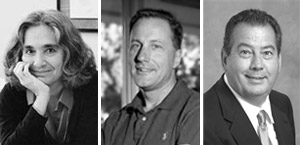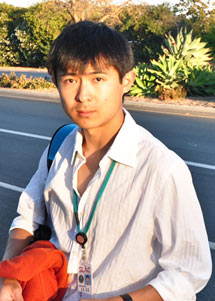

Monday - September 13, 2010
SLAC Today is
available online at:
http://today.slac.stanford.edu
In this issue:
From the Director: Three Years
Zhu to Receive Klein Award
 |
 |
|
Monday - September 13, 2010 |
From the Director: Three Years Paul Golan arrived at SLAC as Department of Energy Site Office manager on August 23, 2007. On September 10, 2007, Persis Drell became acting director of SLAC. Bill Madia didn't officially join as Stanford vice president for SLAC until Jan 1, 2008, but he was there as an advisor from the beginning of our work in SLAC leadership. Three years have gone by in what sometimes feels like slow motion, and at other times feels like lightning speed. We each sat down to comment on where we are and where we are going: Persis: "I have stopped looking back....it's a big change! For a long time I was measuring progress with respect to where we were. Now it's all about where we are going. We are measuring ourselves against where we want to be." Paul: "I see a learning organization in SLAC, the Stanford Site Office, and Stanford, working as a team that is capable of evolutionary and indeed revolutionary change." Bill: "The whole relationship between Stanford, SLAC and the DOE is transformed. It is especially encouraging to see the growing scientific partnerships and outstanding joint appointments between campus departments and SLAC." Read more... Zhu to Receive Klein Award Diling Zhu.
(Photo courtesy Diling Zhu.) Stanford applied physics graduate student Diling Zhu has been chosen as the recipient of the 2010 Melvin P. Klein Scientific Development Award for his work at SLAC's Stanford Synchrotron Radiation Lightsource. Zhu, who completed his Ph.D. research in the Stöhr group, will accept the award October 18 at the joint SSRL-Linac Coherent Lightsource Users' Meeting. The Klein award has been given annually since 2006 to undergraduates, graduate students and postdocs for outstanding research conducted at SSRL. The award comes with a $1,000 prize to help the recipient disseminate his or her scientific results. "This was actually quite a surprise—a very good surprise," Zhu said. "I will do my best to give a good talk at the Users' Meeting." Using SSRL Beamlines 5-2 and 13-3, Zhu worked to develop a new experimental technique to carry out a process called X-ray holography. Whereas regular cameras record photons as they travel like particles, holography makes use of the wave-like properties of light. To do this, researchers illuminate a sample with a beam of coherent X-rays. Some of these X-rays are scattered by the object to be studied, while another portion are scattered by a reference structure. Much as the collision of two small water waves creates new ripple patterns, these two beams of light interact, forming interference patterns. Researchers then collect the scattered X-rays in a detector and typically employ computer algorithms to reconstruct the sample's two-dimensional image. Yet these algorithms require significant computing power and it is difficult to know whether something went wrong. Read more... |
Events
Access (see all)
Announcements
|
|
| | ||
|
|
||
 <%
Response.AddHeader "Last-modified", getArticleDate()
'Response.AddHeader "Last-modified","Mon, 01 Sep 1997 01:03:33 GMT"
'Monday, December 06, 2010
%>
<%
Response.AddHeader "Last-modified", getArticleDate()
'Response.AddHeader "Last-modified","Mon, 01 Sep 1997 01:03:33 GMT"
'Monday, December 06, 2010
%>View online at http://today.slac.stanford.edu/. |
||